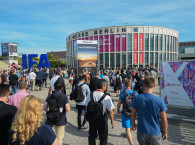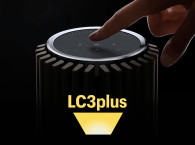
In 2015, IFA received a total of 240,000 visitors and more than 1,600 exhibitors from 60 countries taking 150,000 m2 of exhibition space at the Berlin Exhibition Grounds (Expo Center City) – a 7% growth over the previous year. IFA covers multiple industry segments, starting with Home & Entertainment Electronics (including Smart Home and Home Networks) taking the larger share of the exhibiting space, with Audio Entertainment (HiFi, Loudspeakers, High Performance Audio) taking close to two of the Messe Berlin halls. The rest is Home Appliances, Imaging, Media, Communication, Technology & Components (suppliers).
A clear attraction for any visitor is the city of Berlin, but be prepared for higher prices and crowded restaurants. As a trend for 2016, Messe Berlin expects the topic of UHD (4K and 8K) and new UHD Blu-ray discs to be the main focus, followed closely by wearables. On the audio front, Messe Berlin forecasts a focus on 3D sound and audio objects as “New solutions for the future of sound”. This is a major opportunity to meet with the expanded team of the Fraunhofer Institute IIS, which will be presenting its 3D solution for use in headphones in the Innovation Hall at IFA TecWatch, together with a new 3D audio encoding method, part of MPEG-H.
For 2016, Messe Berlin announced an additional exhibition space outside of the exhibition grounds: the IFA Global Markets space, aimed at trade visitors. The 10,000 square meters of additional exhibition space brings together IFA’s suppliers, component manufacturers, OEMs and ODMs and their potential customers and partners from the CE and HA sectors.
The familiar IFA Trade Visitor Services will also be available at Station Berlin, including a complementary lunch for all trade visitors. Station Berlin is just 20 minutes from the exhibition grounds and can easily be reached via the IFA shuttle buses and local public transport connections. IFA Global Markets will only be open on four days, from the Sunday of IFA (4 September) through to Wednesday (6 September). The IFA trade visitor ticket includes entry to IFA Global Markets.

As the world’s leading trade show for consumer electronics, IFA 2016 will be show-casing innovations non-stop from 2 to 7 September. As In time for the most important time of the year for sales, IFA offers a comprehensive overview of the latest innovations and world firsts: screens for fascinating HDR images, movies for the new UHD Blu-ray discs, eyeglasses and cameras for virtual reality applications, security, comfort, and energy efficiency through smart networks, sensors for fitness and health, superfast 3D scanners, unlimited music offerings from streaming portals and much more.
Smart watches and other wearables, as in devices with sensors and displays worn close to the body, for example on the arm, are a trend set to dominate IFA 2016. Working independently or in combination with a smartphone, these devices display data they receive, track body functions such as heart rate or pulse, count steps, register movement, and monitor environmental variables in order to transfer this information elsewhere for further analysis. An abundance of new smart watches and fitness bracelets will be presented at IFA 2016.

Audio Trends
Cinema sound first began taking over the air space when Dolby augmented the traditional cinema sound with its multichannel technology for right, left, center and surround sound by adding a height dimension. Dolby Atmos has been widely adopted in cinema auditoriums and now it is also included as a feature of home cinema receivers for use in people’s living rooms. Dolby Atmos now has some competition with DTS:X and Auro3D.
The first headphones capable of reproducing 3D sound are also now available. However, these need the right electronic support to create a virtual 3D impression. The Fraunhofer Institute IIS in Erlangen, which played a major part in the development of MP3 technology, is presenting its 3D solution for use in headphones in the Innovation Hall at IFA TecWatch.
Another development from the Erlangen-based institute is a new audio encoding method, which is opening up even more exciting opportunities in addition to 3D sound. It has already been added to the lists of global standards as MPEG-H. The MPEG-H codec can pack multiple audio objects into a single sound data stream, such as different language options which can be selected via the remote control. If sports reporters strain their vocal chords trying to communicate above the loud chants of fans, they will be able to receive some technical aid through the use of MPEG-H sound tracks in the future. TV viewers can use a remote control to control how loud the reporter’s voice is against the background noise. If preferred, viewers can also choose to turn off the commentary entirely and simply enjoy the sounds of the fans in 3D. This principle can also be applied to adjust the volume of movie dialogues. Finally, MPEG-H audio ensures a uniform loudness on every device across programs, channels, and media.
Speakers that connect to playback devices via WiFi or Bluetooth are among the latest trends for outstanding sound at IFA. Then there are internet radio stations and online streaming services. Corresponding platforms are playing an increasingly major role in this domain. Similarly, the matter of whether wireless speaker systems are capable of connecting to these various ser-vices is becoming a more significant factor affecting buyer choice. Many manufacturers are also integrating Google Cast into their wireless speakers.
Another important IFA trend is connectivity between different CE devices and connecting these with household appliances, heating systems, and lighting systems. Desktops, notebooks and network hard drives store immense libraries of digital media nowadays – images, music, videos and more. The home network makes this data accessible to mobile and stationary end devices, including smartphones, tablets, and connected smart TVs. An increasing number of cameras and camcorders transmit their images directly to the home network via wireless Internet.
Most music components and surround systems can now be connected to the home network either wirelessly or via Ethernet cable, meaning they are then able to access and playback media stored on central media libraries. Visitors to IFA 2016 can learn more about the innovations in this area through a large number of products, solutions, and demonstrations.
A large installation known as the e-house further demonstrates through practical examples what progress the industry has been making in terms of allowing communication between very different connected devices. Interoperability – the idea of cross-manufacturer compatibility – is a fundamental requirement at the level of both the German Parliament and the European Union. The e-house also demonstrates how connectivity and intelligent control units can help to save energy, and this is an important part of the process of transforming the way we think about and consume energy. Further inspirational ideas in this domain include electro-mobility and the smart, data-driven transformation of individual transportation.
www.ifa-berlin.com






